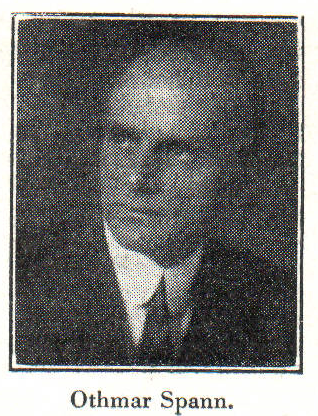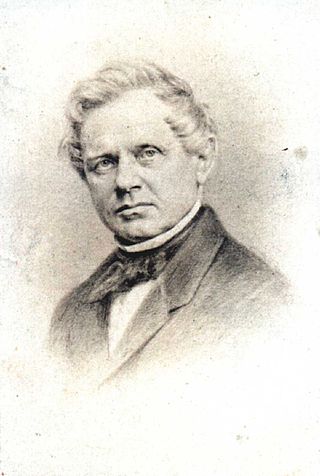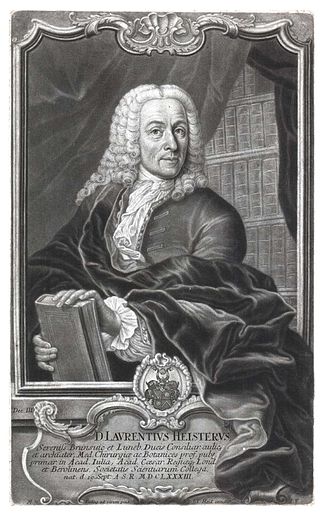
Robert Havemann was an East German chemist and dissident.

Othmar Spann was a conservative Austrian philosopher, sociologist and economist. His radical anti-liberal and anti-socialist views, based on early 19th century Romantic ideas expressed by Adam Müller et al. and popularized in his books and lecture courses, helped antagonise political factions in Austria during the interwar years.

Heinrich Gustav Magnus was a German experimental scientist. His training was mostly in chemistry but his later research was mostly in physics. He spent the great bulk of his career at the University of Berlin, where he is remembered for his laboratory teaching as much as for his original research. He did not use his first given name, and was known throughout his life as Gustav Magnus.

Richard Adolf Zsigmondy was an Austrian-born chemist. He was known for his research in colloids, for which he was awarded the Nobel Prize in chemistry in 1925, as well as for co-inventing the slit-ultramicroscope, and different membrane filters. The crater Zsigmondy on the Moon is named in his honour.

Franz Schreker was an Austrian composer, conductor, librettist, teacher and administrator. Primarily a composer of operas, Schreker developed a style characterized by aesthetic plurality, timbral experimentation, strategies of extended tonality and conception of total music theatre into the narrative of 20th-century music.

Paul Walden was a Russian, Latvian and German chemist known for his work in stereochemistry and history of chemistry. In particular, he discovered the Walden rule, he invented the stereochemical reaction known as Walden inversion and synthesized the first room-temperature ionic liquid, ethylammonium nitrate.

Georg Bredig was a German physical chemist. Bredig was a faculty member at the University of Leipzig (1895-1901) and professor of chemistry at Heidelberg (1901–1910); Technische Hochschule, Zurich (1910); and Technische Hochschule, Karlsruhe (1911–1933).

Heinrich Irenaeus Quincke was a German internist and surgeon. His main contribution to internal medicine was the introduction of the lumbar puncture for diagnostic and therapeutic purposes. After 1874, his main area of research was pulmonary medicine.

Karl-Friedrich Bonhoeffer was a German chemist.
Hermann Lux, was a prominent inorganic chemist from Munich, Germany.

Lorenz Heister was a German anatomist, surgeon and botanist born in Frankfurt am Main.
Carl Grünberg was an Austrian Marxist economist, economic historian and sociologist. He is considered the father of Austromarxism and was the founding director of the Frankfurt Institute for Social Research.
Burghart Schmidt was a German philosopher. He was professor at Hochschule für Gestaltung Offenbach and the University of Applied Arts Vienna.

Ole Jakob Kleppa was a Norwegian–American physical chemist and a pioneer and leading authority in the study of metals, molten salts, ceramics and minerals at high temperatures. Kleppa was a professor at the University of Chicago, where he held appointments in the department of chemistry, the department of geophysical sciences, the James Franck Institute, and the college. He was the director of the James Franck Institute and the materials research laboratory.

Ilie G. Murgulescu was a Romanian physical chemist and a communist politician. He was president of the Romanian Academy (1960–1963) and Minister of Education. He founded the Institute of Physical Chemistry of the Romanian Academy where he presided until 1977. His investigations on physical chemistry covered a broad realm. Among his main results can be cited those he got on molten salts electrochemistry. He did doctoral work on Copper thiosulfate complex photochemistry under Fritz Weigert in Leipzig as adviser.
Otto Kratky was an Austrian physicist. He is best known for his contribution to the small-angle X-ray scattering method, for the Kratky plot, and for the invention of the density metering using the oscillating u-tube principle. The worm-like chain model in polymer physics, introduced with Günther Porod in a 1949 paper, is also named the Kratky–Porod model.
Ernst Hermann Riesenfeld was a German/Swedish chemist. Riesenfeld started his academic career with important contributions in electrochemistry by the side of his mentor Walther Nernst, and continued as a professor with work on the improvement of analytical techniques and the purification of ozone. Dismissed and prosecuted in Nazi Germany due to his Jewish origins, he emigrated to Sweden in 1934 and continued his ozone-related work there until retirement.
Karl Söllner was an Austrian-American chemist, primarily active in the field of physical chemistry and biophysics.

Louis Albrecht Kahlenberg was an American chemist who contributed to electrochemistry, the study of ionic compounds, electrolytic disassociation of salts and studies in pharmaceutical chemistry. He served as a professor at the University of Wisconsin.

Ivan Alekseyevich Kablukov was a Russian and Soviet physical chemist. He simultaneously and independently of Vladimir Kistiakovsky proposed the idea of ion solvation and initiated the unification of the physical and chemical theory of solutions. He published influential textbooks on organic chemistry and was a professor at Moscow State University and Timiryazev Agricultural Academy.














